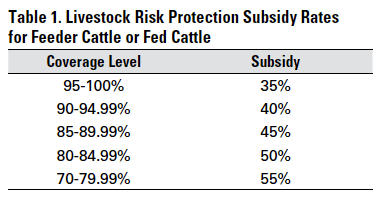Recognizing Animals Danger Defense (LRP) Insurance: A Comprehensive Guide
Navigating the realm of animals danger protection (LRP) insurance policy can be a complicated undertaking for several in the agricultural market. From just how LRP insurance policy functions to the various insurance coverage options available, there is much to reveal in this thorough guide that might potentially shape the way livestock producers come close to danger monitoring in their services.

Exactly How LRP Insurance Coverage Works
Occasionally, comprehending the auto mechanics of Animals Danger Security (LRP) insurance coverage can be complex, yet breaking down how it functions can supply clearness for farmers and breeders. LRP insurance policy is a threat monitoring tool designed to protect livestock manufacturers versus unforeseen rate declines. The policy allows producers to establish a protection level based upon their details needs, picking the variety of head, weight array, and insurance coverage rate. As soon as the policy is in area, if market costs drop listed below the protection price, manufacturers can submit an insurance claim for the difference. It is very important to note that LRP insurance coverage is not a profits guarantee; instead, it concentrates solely on cost risk security. The protection duration normally ranges from 13 to 52 weeks, supplying adaptability for producers to choose a period that straightens with their production cycle. By utilizing LRP insurance policy, herdsmans and farmers can alleviate the financial threats connected with changing market rates, making sure better security in their operations.
Qualification and Protection Options

When it comes to coverage alternatives, LRP insurance policy supplies manufacturers the adaptability to pick the insurance coverage degree, protection period, and endorsements that finest fit their risk management needs. By comprehending the qualification criteria and insurance coverage options available, animals producers can make informed decisions to handle risk successfully.
Advantages And Disadvantages of LRP Insurance
When evaluating Animals Danger Protection (LRP) insurance, it is important for livestock producers to evaluate the benefits and drawbacks inherent in this danger administration device.

One of the primary benefits of LRP insurance coverage is its ability to supply defense against a decline in livestock costs. This can aid protect manufacturers from financial losses resulting from market fluctuations. Additionally, LRP insurance supplies a level of versatility, permitting producers to customize insurance coverage degrees and plan durations to match their specific requirements. By securing an ensured cost for their animals, manufacturers can much better take care of threat and prepare for the future.
However, there are additionally some disadvantages to consider. One limitation of LRP insurance go right here is that it does not protect against all types of risks, such as disease outbreaks or natural disasters. Additionally, premiums can sometimes be pricey, specifically for manufacturers with big livestock herds. It is important for manufacturers to thoroughly evaluate their specific risk exposure and monetary circumstance to figure out if LRP insurance policy is the appropriate threat monitoring device for their operation.
Recognizing LRP Insurance Policy Premiums

Tips for Optimizing LRP Perks
Taking click for more full advantage of the advantages of Livestock Threat Protection (LRP) insurance requires calculated preparation and proactive danger monitoring - Bagley Risk Management. To make the many of your LRP protection, think about the following suggestions:
Frequently Evaluate Market Problems: Remain educated regarding market trends and cost changes in the livestock sector. By monitoring these factors, you can make educated choices regarding when to purchase LRP insurance coverage to secure versus potential losses.
Establish Realistic Protection Degrees: When picking protection degrees, consider your manufacturing costs, market price of livestock, and possible risks - Bagley Risk Management. Establishing realistic coverage levels ensures that you are sufficiently secured without overpaying for unnecessary insurance
Diversify Your Coverage: As opposed to depending exclusively on LRP insurance coverage, consider expanding your danger administration strategies. Incorporating LRP with various other danger management tools such as futures agreements or alternatives can supply detailed protection against market uncertainties.
Testimonial and Readjust Insurance Coverage Consistently: As market conditions change, regularly examine your LRP protection to ensure it aligns with your existing danger exposure. Changing coverage levels and timing of acquisitions can help maximize your risk defense technique. By adhering to these suggestions, you can make best use of the advantages of LRP insurance coverage and guard your livestock procedure against unexpected threats.
Conclusion
To conclude, livestock danger security (LRP) insurance is an important device for farmers to handle the financial dangers connected with their animals procedures. By recognizing just how LRP works, eligibility and insurance coverage options, along with the benefits and drawbacks of this insurance policy, farmers can make informed decisions to shield their incomes. By meticulously thinking about LRP costs and implementing methods to make best use of benefits, farmers can mitigate prospective losses and guarantee the sustainability of their procedures.
Livestock manufacturers interested in acquiring Livestock Danger Protection (LRP) insurance policy can discover a variety of qualification requirements and insurance coverage alternatives customized to their specific livestock procedures.When it comes to insurance coverage options, LRP go now insurance policy offers manufacturers the adaptability to select the coverage level, coverage duration, and endorsements that ideal suit their danger management demands.To comprehend the details of Livestock Danger Protection (LRP) insurance fully, comprehending the aspects affecting LRP insurance coverage premiums is important. LRP insurance coverage premiums are determined by numerous aspects, including the coverage degree picked, the anticipated rate of animals at the end of the insurance coverage period, the kind of animals being guaranteed, and the size of the insurance coverage duration.Evaluation and Change Coverage Consistently: As market conditions change, regularly evaluate your LRP insurance coverage to guarantee it aligns with your existing risk direct exposure.